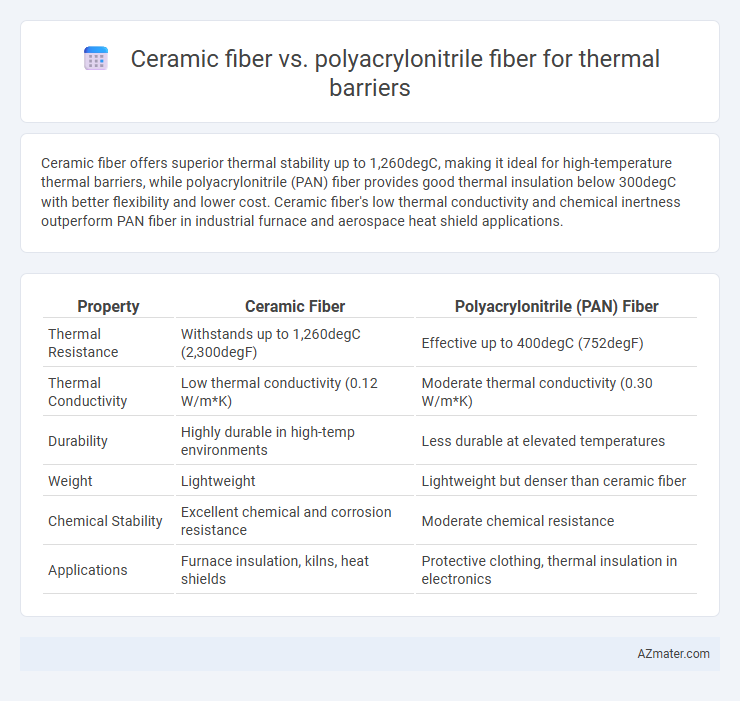Ceramic fiber offers superior thermal stability up to 1,260degC, making it ideal for high-temperature thermal barriers, while polyacrylonitrile (PAN) fiber provides good thermal insulation below 300degC with better flexibility and lower cost. Ceramic fiber's low thermal conductivity and chemical inertness outperform PAN fiber in industrial furnace and aerospace heat shield applications.
Table of Comparison
| Property | Ceramic Fiber | Polyacrylonitrile (PAN) Fiber |
|---|---|---|
| Thermal Resistance | Withstands up to 1,260degC (2,300degF) | Effective up to 400degC (752degF) |
| Thermal Conductivity | Low thermal conductivity (0.12 W/m*K) | Moderate thermal conductivity (0.30 W/m*K) |
| Durability | Highly durable in high-temp environments | Less durable at elevated temperatures |
| Weight | Lightweight | Lightweight but denser than ceramic fiber |
| Chemical Stability | Excellent chemical and corrosion resistance | Moderate chemical resistance |
| Applications | Furnace insulation, kilns, heat shields | Protective clothing, thermal insulation in electronics |
Introduction to Thermal Barrier Materials
Ceramic fiber and polyacrylonitrile (PAN) fiber are widely used thermal barrier materials due to their excellent heat resistance and insulating properties. Ceramic fibers provide superior high-temperature stability, withstanding environments above 1000degC, making them ideal for furnace linings and industrial kilns. PAN fibers offer lower thermal conductivity and lightweight characteristics, commonly used in aerospace and automotive applications for thermal insulation and fire resistance.
Overview of Ceramic Fiber
Ceramic fiber offers exceptional thermal insulation properties withstanding temperatures up to 1300degC, making it ideal for high-temperature thermal barrier applications. Its low thermal conductivity, high chemical stability, and resistance to thermal shock enable effective energy conservation and durability in industrial furnaces and kilns. Compared to polyacrylonitrile fiber, ceramic fiber provides superior heat resistance and structural integrity in extreme environments.
Overview of Polyacrylonitrile (PAN) Fiber
Polyacrylonitrile (PAN) fiber is a synthetic polymer widely used for thermal barrier applications due to its excellent thermal stability and flame resistance. Compared to ceramic fiber, PAN fiber offers superior flexibility, lightweight properties, and ease of processing, making it suitable for wearable insulation and aerospace applications. Its high carbon yield upon pyrolysis also enhances structural integrity and thermal protection in high-temperature environments.
Thermal Insulation Properties Comparison
Ceramic fiber exhibits superior thermal insulation properties with a high melting point above 1700degC, low thermal conductivity around 0.1-0.2 W/m*K, and excellent resistance to thermal shock, making it ideal for extreme high-temperature applications. Polyacrylonitrile (PAN) fiber, commonly used as a precursor for carbon fiber, offers moderate thermal stability up to about 300degC and provides decent insulating properties but lacks the high-temperature endurance of ceramic fibers. The significant difference in thermal conductivity and temperature resistance highlights ceramic fiber as a preferred thermal barrier material in refractory and industrial furnace environments.
Heat Resistance and Maximum Operating Temperatures
Ceramic fiber offers superior heat resistance with maximum operating temperatures up to 1260degC to 1430degC, making it ideal for high-temperature thermal barriers in industrial applications. Polyacrylonitrile (PAN) fiber, while effective at moderate temperatures, typically withstands maximum operating temperatures around 200degC to 300degC, limiting its use in extreme heat environments. The significant difference in thermal stability highlights ceramic fiber's advantage for applications requiring prolonged exposure to intense heat.
Mechanical Strength and Durability
Ceramic fibers exhibit superior mechanical strength and durability compared to polyacrylonitrile (PAN) fibers when used as thermal barriers, thanks to their high-temperature resistance and structural stability up to 1600degC. PAN fibers, often carbonized for improved thermal performance, offer good tensile strength but degrade faster under prolonged exposure to extreme heat and oxidative environments. Ceramic fibers maintain integrity under thermal cycling and mechanical stress, making them preferable for demanding applications such as furnace linings and aerospace insulation.
Chemical Stability and Corrosion Resistance
Ceramic fiber exhibits superior chemical stability and corrosion resistance compared to polyacrylonitrile (PAN) fiber, making it ideal for high-temperature thermal barrier applications. Ceramic fibers maintain structural integrity in aggressive chemical environments and resist degradation from acids, alkalis, and oxidation at temperatures exceeding 1000degC. PAN fibers, while offering good thermal insulation, tend to degrade and lose strength when exposed to harsh chemicals and oxidative conditions, limiting their effectiveness in corrosive environments.
Cost and Availability
Ceramic fiber offers superior thermal resistance and durability at a higher cost, often preferred for industrial high-temperature applications, though its availability can be limited due to specialized production processes. Polyacrylonitrile (PAN) fiber provides a more cost-effective solution with moderate thermal insulation properties and broader availability, widely used in textiles and lower-temperature thermal barriers. Manufacturers typically consider ceramic fiber for critical thermal protection despite expense, while PAN fiber is favored where budget constraints and material accessibility are priorities.
Environmental and Safety Considerations
Ceramic fiber offers exceptional thermal resistance and is highly effective as a thermal barrier but poses health risks due to its fibrous dust, which can cause respiratory issues if inhaled, necessitating stringent handling protocols and protective equipment. Polyacrylonitrile (PAN) fiber, often used as a precursor for carbon fiber, provides good thermal insulation with lower respiratory hazards compared to ceramic fibers, but it is flammable and releases toxic gases when burned, requiring careful fire safety measures. From an environmental perspective, ceramic fibers are more chemically stable but less biodegradable, while PAN fibers, although synthetic and less environmentally persistent, generate hazardous byproducts during production and incineration.
Applications and Suitability for Thermal Barrier Solutions
Ceramic fiber excels in high-temperature environments, offering exceptional thermal insulation for applications such as furnace linings, kilns, and exhaust systems, where it withstands temperatures up to 1430degC. Polyacrylonitrile (PAN) fiber is commonly used in thermal barrier coatings and insulation materials in aerospace and automotive industries due to its lightweight nature and moderate heat resistance up to 300degC. Ceramic fibers are more suitable for extreme heat and direct flame exposure, while PAN fibers are preferable for flexible, lightweight applications requiring moderate thermal protection.

Infographic: Ceramic fiber vs Polyacrylonitrile fiber for Thermal barrier
 azmater.com
azmater.com